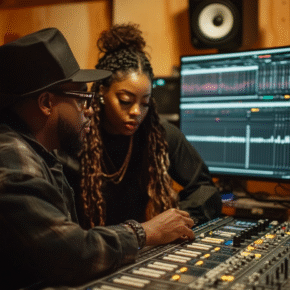When it comes to music streaming, mixing & mastering for streaming are non-negotiable. A well-mixed and mastered track grabs listeners’ attention and keeps them engaged. Streaming platforms like Spotify and Apple Music prioritize high-quality tracks, so your music needs to meet those standards. These processes not only enhance your sound but also boost your chances of success on digital platforms.
Why Mixing & Mastering Matter for Streaming
Making a Strong First Impression
The first few seconds of a song determine whether listeners stay or skip. Proper mixing and mastering ensure your track sounds polished from the start.
Meeting Platform Standards
Streaming platforms have technical requirements, such as specific loudness levels. Mastering ensures your track meets these standards, avoiding playback issues.
Enhancing the Listening Experience
Mixing balances your track’s elements, while mastering adds depth and clarity. Together, they create an immersive experience that keeps audiences hooked.

How Mixing & Mastering Boost Streaming Performance
Increased Retention Rates
Listeners are more likely to play your song to the end if it sounds professional. Proper mixing and mastering eliminate jarring audio issues that cause skips.
Better Playlist Placement
A polished track has a higher chance of being added to curated playlists. This exposure is key to increasing streams and growing your fan base.
Optimized for Algorithms
Streaming platforms reward high-engagement tracks. Well-mastered songs perform better because they keep listeners engaged, boosting your visibility.
Key Steps in Mixing & Mastering for Streaming
Balancing the Mix
A balanced mix ensures vocals, instruments, and effects work harmoniously. This prevents any one element from overpowering the others.
Adjusting Loudness Levels
Mastering optimizes your track’s volume, ensuring it sounds consistent across different devices and platforms.
Refining Clarity and Tone
Mixing highlights key elements, while mastering fine-tunes the overall sound, adding a professional touch.
Exporting in the Right Format
Mastering ensures your track is delivered in the correct file format (e.g., WAV or MP3) to meet platform requirements.
Transform your next hit?
How to Prepare Your Music for Mixing & Mastering
Organize Your Files
Label tracks clearly and remove any unwanted noise. This helps engineers work efficiently and focus on refining your sound.
Provide Reference Tracks
Share examples of songs that reflect the sound you want. This gives engineers a clear understanding of your vision.
Collaborate with Professionals
Experienced mixing and mastering engineers bring expertise and tools that elevate your music to professional standards.
FAQs About Mixing & Mastering for Streaming
Why are mixing and mastering important for streaming?
They ensure your track sounds polished, meets platform standards, and keeps listeners engaged.
Can I mix and master my own music?
Yes, but professional engineers deliver higher-quality results due to their expertise.
What is loudness normalization?
It’s the process streaming platforms use to adjust playback levels, ensuring consistent volume across tracks.
How long does the process take?
Mixing and mastering typically take a few hours to several days, depending on the project’s complexity.
Do I need separate mastering for each platform?
In most cases, one properly mastered track works across all streaming platforms.
Conclusion
Investing in mixing & mastering for streaming is essential for any artist aiming for success in the digital space. These processes ensure your music sounds professional, meets platform requirements, and captivates your audience. By prioritizing polished sound quality, you increase your chances of engagement, playlist placements, and long-term streaming success.





